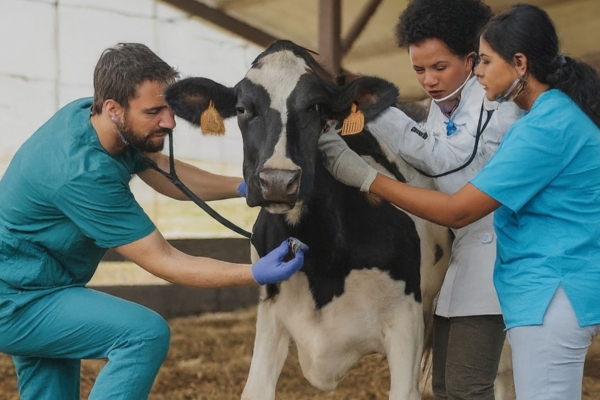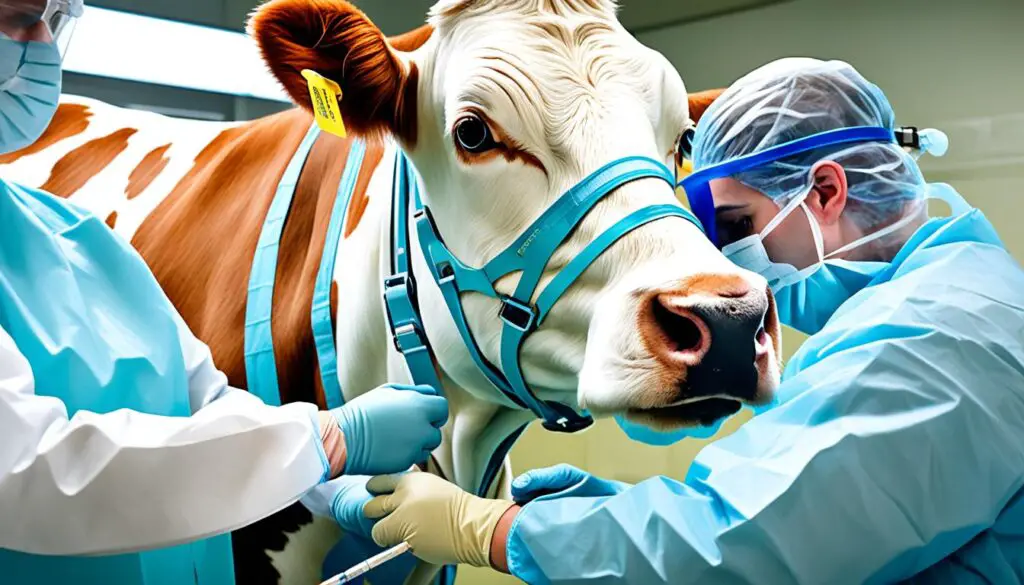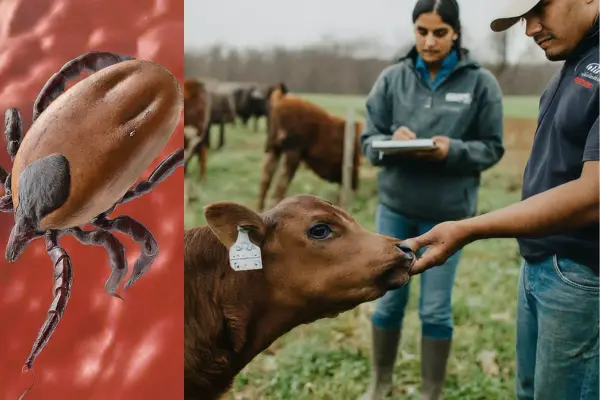In the agricultural heartlands of America, a staggering 3.5 million cattle may be carriers of Anaplasmosis, a figure that underscores the scale of this hidden threat. Anaplasmosis in cows, often referred to as yellow fever or yellow bag, represents a significant challenge in livestock management.
This infectious disease, mostly spread by ticks, ravages through herds causing severe anemia and can be fatal if left unchecked. Understanding the causes, recognizing the symptoms, and implementing effective prevention strategies are imperative for farmers and ranchers in the fight against cattle anaplasmosis.
The drive for proactive management is fueled by the disease’s high impact on cattle health, productivity, and farmer’s livelihoods. Although the condition can be managed, awareness remains pivotal, as the nuances of Anaplasmosis Symptoms and Prevention in Cattle are often overlooked.
From identifying the early signs to employing comprehensive preventative measures, navigating through the complexities of anaplasmosis in cattle is critical for sustaining agriculture’s backbone—our livestock.
Understanding Anaplasmosis in Cattle
As a complex and impactful disease affecting the bovine population, anaplasmosis poses serious threats to livestock health and agricultural productivity.
This disease, although often overlooked, requires meticulous attention due to its devastating potential. In this section, we delve into what anaplasmosis is, identify the main culprits responsible for the disease, and discuss its method of spread among cattle populations.
Defining Anaplasmosis and Its Significance
Anaplasmosis is a hematologic disease that wreaks havoc on the red blood cells of cattle, leading to severe anemia and a host of other symptoms that can considerably diminish an animal’s health and productivity.
This disease not only impacts the wellbeing of affected animals but also leads to economic losses for farmers due to decreased meat and milk production and potential fatalities.
The pivotal nature of understanding this disease cannot be overstated, particularly in terms of how to effectively deliver anaplasmosis treatment and implement preventive measures.

Pathogens Behind the Disease: Anaplasma Marginale and Centrale
The primary agents of anaplasmosis are the rickettsial parasites known as Anaplasma marginale and Anaplasma centrale. These parasites seek out and invade cattle red blood cells, causing their destruction.
The result is a sequence of symptoms ranging from mild fever to severe anemia and, in the worst cases, death. Identifying these culprits is the first step in formulating a response to manage and prevent anaplasmosis in cattle.
The Vector-Borne Nature of Anaplasmosis
One of the pivotal aspects of fighting anaplasmosis is understanding its transmission mechanisms. As a vector-borne disease, anaplasmosis is primarily spread through the bites of infected ticks. These ticks act as carriers, transferring the disease from one animal to another, facilitating a rapid spread through a herd if left uncontrolled.
The prevalence of anaplasmosis in regions with high tick populations makes it essential to target vectors as part of an integrated disease management strategy.
Focusing on tick control can significantly reduce the incidence of anaplasmosis and is a critical component in the effort to prevent anaplasmosis in cattle. Farmers and veterinarians collaborate to establish effective vector control programs that often combine acaricides with environmental management practices.
By managing the disease vectors, the industry aims to protect livestock health and ensure the wellbeing and productivity of cattle herds across the nation.

Anaplasmosis Symptoms and Prevention in Cattle
When considering the health of cattle herds, it is essential to recognize the signs of anaplasmosis in cattle to ensure timely management of the disease.
Characteristic symptoms include anemia, evidenced by a reduction in the red blood cell count, leading to — fever, weight loss, breathlessness, and the appearance of jaundice.
Furthermore, cattle may display uncoordinated movements, and in pregnant cows, there is a risk of abortion. If anaplasmosis goes undetected or untreated, it can unfortunately lead to fatalities among the herd.
Preventive measures are just as central in the fight against anaplasmosis as are treatment strategies. The introduction of an anaplasmosis vaccine offers a proactive approach to protect cattle from this debilitating disease.
Alongside vaccination, maintaining rigorous control over vector populations, primarily ticks, is a critical preventive strategy. Administering medication during seasons of increased risk can also mitigate the potential spread of anaplasmosis among cattle.
For a detailed understanding, here are some of the prevalent symptoms and preventive approaches:
- Anemia – Pale mucous membranes signaling decreased red blood cells
- Fever – Elevated body temperature
- Weight Loss – Reduction in normal weight gain patterns
- Breathlessness – Difficulty breathing, a sign of reduced oxygen-carrying capacity
- Jaundice – Yellow discoloration of skin and mucous membranes due to red blood cell destruction
- Uncoordinated Movements – Lack of stability, potentially from oxygen deprivation or fever
- Abortion in Pregnant Cows – Loss of pregnancy as a disease consequence
Prevention strategies include:
- Vaccine Utilization – Application of an anaplasmosis vaccine in areas with high disease prevalence
- Vector Control – Implementation of tick management through acaricides and environmental modifications
- Treatment During High-Risk Periods – Use of tetracycline antibiotics when the risk is greatest
- Monitoring of Herd Health – Regular assessment of cattle for early detection of anaplasmosis signs
Early recognition of anaplasmosis signs facilitates immediate intervention, increasing the efficacy of treatments and preventing large-scale outbreaks within the herd. By combining both preventive vaccinations and treatments with careful observation of cattle behavior and health, ranchers can maintain herd productivity and welfare.
Identifying the Signs of Anaplasmosis in Cows

Recognizing early signs of anaplasmosis can be the key to managing and preventing the spread of this disease within cattle herds. Farmers and veterinarians should pay close attention to anaplasmosis symptoms and prevention in cattle to mitigate the effects of this illness. Below is a detailed overview of the clinical signs that merit swift attention and action.
| Symptom | Description | Preventive Tips |
|---|---|---|
| Anemia | Pale or yellow mucous membranes indicative of reduced red blood cell count. | Regular health check-ups to detect and treat early. |
| Fever | Elevated body temperature as a response to infection. | Monitoring temperature during tick season. |
| Weight Loss | Significant reduction in body weight, impacting overall health. | Maintain nutritional support especially during recovery. |
| Labored Breathing | Increased respiratory effort correlating with anemic conditions. | Observing cattle for abnormal breathing patterns. |
| Jaundice | Yellowing of skin and eyes due to liver impact. | Ensuring good liver health with appropriate diet. |
| Disruption in Coordination | Incoordination or difficulty in moving properly. | Creating a safe environment to minimize injury from falls. |
| Potential Death | Fatality if conditions are left untreated. | Prompt treatment upon detection of symptoms. |
Timely identifying anaplasmosis causes and symptomatic cows is pivotal in initiating proper treatment protocols. The disease progresses rapidly and can become fatal if overlook. Therefore, incorporating anaplasmosis symptoms and prevention in cattle into routine herd health assessments is a must for cattle producers.
Preventive strategies such as tick control, good nutritional practices, and seeking veterinary guidance for herd health programs can significantly curb the spread and impact of anaplasmosis on cattle farms.

Critical Impacts of Anaplasmosis on Adult Cattle and Calves
Anaplasmosis in cows can have a profound impact on livestock, affecting productivity and herd health. Understanding where specific age groups stand in terms of susceptibility and recovery outcomes is of the essence when managing anaplasmosis in cattle. Here, we delve into how age can influence the disease and the implications of the carrier state in recovered cattle.
Age-Related Susceptibility to Anaplasmosis
The severity of anaplasmosis varies depending on the age of the infected cattle. While younger calves might exhibit a more resilient response to the infection, mature cattle are at heightened risk of experiencing acute, potentially fatal symptoms. Recognizing these age-related differences is key in deploying the right management strategy.
| Age Group | Risk Level | Most Common Symptoms | Management Strategies |
|---|---|---|---|
| Under 1 year | Low | Mild anemic signs, slight fever | Monitoring, maintaining vector control |
| 1-2 years | Moderate | Moderate anemia, fever, potential weight loss | Supplemental nutrition, increased surveillance |
| Over 3 years | High | Severe anemia, high fever, jaundice, risk of fatality | Immediate treatment, strict vector control measures |
The Carrier State in Recovered Cattle
After recovery from an active infection, cattle may enter a carrier state where they exhibit no symptoms but remain capable of transmitting anaplasmosis to other members of the herd.
This silent transmission poses a significant challenge in managing the disease, emphasizing the need for continual monitoring and strategic control measures to prevent the spread.

Protecting the herd involves more than treating the afflicted; it requires a comprehensive, knowledgeable approach to the disease life cycle, including recognizing and addressing the carrier state in recovered cattle.
Diagnosis and Anaplasmosis Treatment Options
The key to controlling anaplasmosis lies in early and accurate diagnosis followed by effective treatment. Recognizing clinical signs is crucial, but definitive diagnosis necessitates laboratory assistance.
Skilled veterinarians conduct tests such as microscopic examination of blood smears and antibody detection to confirm the presence of anaplasmosis in livestock. Upon diagnosis, anaplasmosis treatment generally commences with the administration of tetracycline antibiotics.

It is important to note that while tetracycline can mitigate symptoms and improve survival rates, animals commonly enter a carrier state post-treatment. In this state, they harbor the pathogen without showing signs of illness, yet pose a risk for transmitting the disease to other members of the herd. Here are the treatment steps typically advised:
- Immediate administration of tetracycline antibiotics at the onset of symptoms.
- Continuous monitoring of animals during treatment to evaluate effectiveness.
- Follow-up testing to identify carrier state.
However, treatment efficacy varies, and complete eradication of the bacteria from the carrier animals remains challenging. Efforts to achieve this include:
- More intensive and prolonged antibiotic treatment regimens.
- Consideration of environmental and management factors that can reduce stress and susceptibility.
Despite these measures, the success of eliminating the carrier state has been inconsistent, necessitating ongoing research and alternative strategies. In the meantime, prevention through management practices and vector control remains an essential component of anaplasmosis treatment programs.
Prevent Anaplasmosis in Cattle: Strategies and Methodologies
Anaplasmosis prevention is a multifaceted approach necessitating vigilance and strategic planning, especially in areas where ticks thrive. Preventing anaplasmosis in cattle is not just advisable; it is essential for sustaining a healthy and profitable livestock operation. By utilising various proven techniques and modern advancements like the anaplasmosis vaccine, farmers can significantly reduce the incidence of this condition in their herds.
Vector Control as a Preventive Measure
Ticks are the primary vector for the transmission of anaplasmosis among cattle. As such, controlling these vectors is crucial and should be prioritised, particularly during late summer and fall, which are peak times for tick activity.
Employing a combination of acaricides (tick pesticides), and environmental management can dramatically decrease tick populations and minimize the risks of anaplasmosis transmission.

Managing Medications and Vaccination
Prophylactic medication schemes are integral to preventing anaplasmosis in cattle. Implementing the use of medicated feeds or mineral supplements containing chlortetracycline has been shown to be effective during periods of high tick activity.
Additionally, the strategic use of oxytetracycline injections offers another layer of prevention. In regions where it’s available, the anaplasmosis vaccine can stimulate the immune response of cattle, enhancing their natural ability to fend off the disease.
Nutritional Interventions for Anaplasmosis Prevention
It is well acknowledged that a well-balanced diet enriched with essential minerals and nutrients contributes to overall cattle health and disease resistance. By bolstering the immunity of the herd through strategic nutritional support, cattle are better equipped to withstand pathogens, including those responsible for anaplasmosis.
| Prevention Strategy | Details | Implementation Period |
|---|---|---|
| Tick Control | Use of acaricides and environmental management to reduce tick populations | Late summer and fall |
| Medicated Feeds | Incorporation of chlortetracycline in feeds and mineral blocks to prevent transmission | Peak vector seasons |
| Oxytetracycline Injections | Administer injections as a preventative measure during high-risk periods | Before vector season and as needed |
| Supplemental Nutrition | Provide minerals and vitamins to enhance herd immunity and resilience | Year-round with adjusted rations during high-risk periods |
| Anaplasmosis Vaccine | Vaccination to induce immunity against anaplasmosis pathogens | As recommended by a veterinarian or as per regional guidelines |
Managing Anaplasmosis in Cattle Through Insect Control
Effective control of anaplasmosis in cows hinges on proactive insect management to curb anaplasmosis transmission. By addressing vector populations head-on, farmers and cattle ranchers can create a more resilient and healthy herd environment. Here, we delve into methods to manage the tick and fly populations that act as vectors for anaplasmosis, along with best practices to maintain hygiene in cattle management.
Tackling Tick and Fly Populations
Managing ticks and flies not only diminishes the nuisance for cattle but also lessens the risk of disease spread. A comprehensive approach includes regular application of vet-approved insecticides and introducing feed-through fly control products. The adherence to a consistent schedule can significantly reduce vector populations and, consequently, the rate of infections.
- Implementation of a strategic acaricide program
- Use of fly traps and baits in cattle areas
- Introduction of biological control agents
- Pasture rotation to disrupt the life cycle of ticks
Ensuring Hygiene in Cattle Management Practices
Maintaining superior hygiene within the cattle operations is crucial to avoid indirect transmission of anaplasmosis. The following table outlines essential practices for enhancing hygiene within cattle management to prevent disease outbreak.
| Hygiene Practice | Objective | Method |
|---|---|---|
| Cleaning of Equipment | Eliminate potential pathogens from tools and surfaces | Use of appropriate disinfectants on dehorners, tattoo instruments, and needles |
| Proper Disposal | Prevent the breeding of vectors | Regular removal of manure and disposal away from grazing areas |
| Environmental Modifications | Reduce habitat suitability for ticks and flies | Manage vegetation, improve drainage, and minimize standing water |
| Sanitation Protocols | Stop cross-contamination between animals | Establish biosecurity measures and monitor cattle movement |
By integrating these practices, the risk of anaplasmosis spread through flies and ticks is considerably reduced. Moreover, it reinforces the overall welfare of the cattle and the sustainability of the farming operation.

Anaplasmosis Transmission: Understanding and Mitigating Risks
The spread of anaplasmosis among cattle herds is a substantial concern, warranting effective intervention strategies to halt anaplasmosis transmission.
Transmission pathways include biological vectors, such as ticks and tabanid flies, and mechanical means like contaminated needles during veterinary procedures. By delineating the transmission routes, cattle producers can adopt targeted measures to protect their livestock.
One of the primary vectors in transmitting anaplasmosis are ticks, which harbor the Anaplasma organisms. When these ticks feed on the blood of a susceptible cow, they transfer the organisms, establishing a new infection. It is essential for producers to implement tick control strategies, especially during peak tick activity seasons, to minimize the risk.
Furthermore, fly populations, particularly tabanid flies, are capable of transferring the disease through transient mechanical transfer of blood between animals. Measures to control fly populations on farms help curb the indirect transmission of anaplasmosis.
| Vector | Transmission Mechanism | Control Measures |
|---|---|---|
| Ticks | Biological transmission via feeding | Use of acaricides, environmental management |
| Tabanid flies | Mechanical transmission through blood transfer | Insect traps, insecticide sprays, on-animal repellent |
| Contaminated equipment | Use of hypodermic needles between animals | Strict sanitation protocols, single-use needles |
It’s crucial that equipment such as needles and surgical tools are either single-use or thoroughly sanitized between uses to prevent anaplasmosis transmission in cattle.
Biosecurity measures should be an integral part of farm management. They include quarantining new animals, testing them for anaplasmosis, and implementing buffer zones between herds.
- Identification and control of vectors responsible for anaplasmosis.
- Implementation of hygiene protocols to prevent disease spread through equipment.
- Educate and train farm personnel on biosecurity to minimize risks.
Integrating these controls and preventive measures helps safeguard the health of the herd and sustains cattle production without the setbacks posed by anaplasmosis outbreaks.
Conclusion
As we have explored the multi-faceted nature of anaplasmosis in the livestock industry, it’s evident that managing anaplasmosis in cattle is an intricate and critical task. This disease, driven largely by anaplasmosis causes such as vector transmission and insufficient biosecurity measures, can result in considerable economic losses and animal welfare issues.
Farmers and veterinarians alike must be vigilant in observing the health of their herds, swiftly identifying symptomatic cattle, and taking deft action to treat the infection.
The application of targeted treatments, alongside ongoing surveillance for disease symptoms, forms the bedrock of any effective anaplasmosis management program. However, prevention is always preferable to cure. The establishment and maintenance of rigorous preventive protocols are paramount.
This includes diligent vector control strategies, such as the use of acaricides and environmental management, coupled with strict hygiene practices during husbandry procedures to mitigate the risk of disease transmission.
Ultimately, the combination of tailored treatment plans, robust anaplasmosis prevention efforts, and the cultivation of partnerships with knowledgeable veterinary professionals forms the cornerstone of safeguarding cattle from this challenging disease.
By adopting proven management strategies and staying informed on the latest research and developments, cattle producers can significantly reduce the prevalence and impact of anaplasmosis on their operations, ensuring the health and productivity of their valuable herds.


